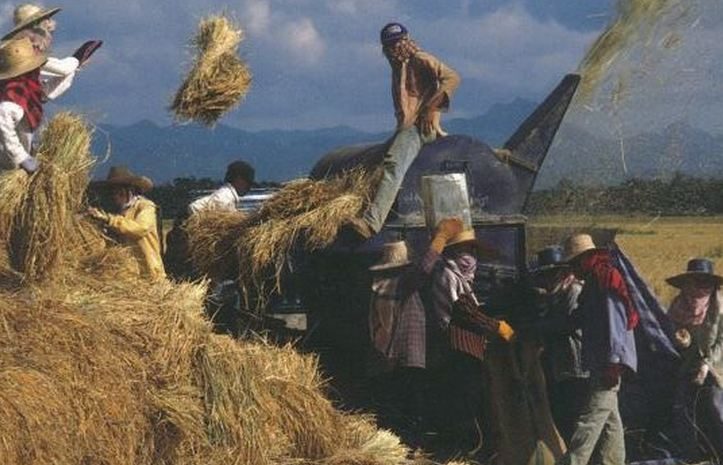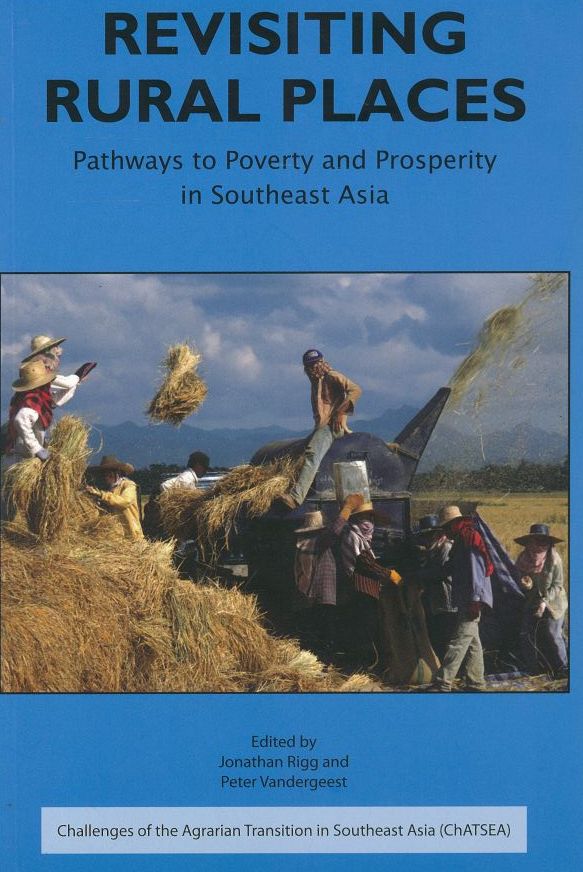Jonathan Rigg and Peter Vandergeest, editors, Revisiting Rural Places: Pathways to Poverty and Prosperity in Southeast Asia
Singapore and Manoa: NUS Press and the University of Hawaii Press, 2012. Pp. xxiv, 351; tables, figures, maps, photographs, appendices, glossary, bibliography, index.
Reviewed by Eric C. Thompson.
The Challenges of the Agrarian Transition in Southeast Asia (ChATSEA) project – led by Rodolphe De Koninck, sponsored by the Social Sciences and Humanities Research Council of Canada, and involving more than two dozen researchers and collaborators – has resulted in a productive program of investigation of social, economic and political change across rural Southeast Asia. Revisiting Rural Places is one of several recently published books that are the fruit of the ChATSEA project (see also Caouette and Turner, eds. 2009; De Koninck et al., eds. 2011; Hall et al. 2011; Sikor et al., eds. 2011). It is the most broadly conceived of these recent volumes, containing fourteen chapters focusing on single-case re-studies across half a dozen countries. It also includes two introductory chapters framing the approach and main findings of the research. The intervals between the original studies and the re-studies presented in this volume were between forty and ten years. The ChATSEA researchers conducted all of the re-studies in this volume in 2009, with the exception of one undertaken in 2006 (Bruneau’s chapter on Northern Thailand).
Revisiting Rural Places should become an essential reference text for researchers who work on social, cultural, political and economic change in Asia and elsewhere. It is especially important for those researchers who endeavor to understand change at the intimate, qualitative level of everyday life, rather than through the lens of quantitative, macro-economic or demographic data. As the authors of the first of the two introductory chapters point out, this is a rare and particularly rich example of social scientists undertaking re-studies of places in which they have conducted intensive prior field-work. The diversity of the case studies in Revisiting Rural Places is also particularly valuable in highlighting both common and divergent experiences among rural people and places during the late twentieth and early twenty-first centuries.
The two introductory chapters provide valuable discussions to the case studies that follow. The first chapter, by Peter Vandergeest and Jonathan Rigg, discusses the “restudy” framework of the book. As the chapter points out, re-studies are less common than one might expect. The chapter’s authors also note the problem of attempting comparative re-studies by field researchers who inevitably take idiosyncratic approaches to their research and are influenced by shifting trends in social research. The strength of this volume stands as testament to the value both of re-studies and of comparative collaboration among researchers across diverse field sites. The second chapter, by De Koninck and the two authors of the first chapter, offers a broad overview of change in Southeast Asia based on national-level data and a comparison of main trends across the fourteen cases in the book.
The principal focus of the book and of most of the case studies is on the political economy of rural lives and livelihoods – as the subtitle states, on “pathways to poverty and prosperity.” Not surprisingly, given the macro-economic history of Southeast Asia during the last half-century and particularly during the past twenty years, the general trend has been one of increasing material prosperity. Where pathways to poverty are observed, they are more often indexed by relative poverty and widening gaps between rich and poor than by absolute poverty or immiseration. At the same time, many chapters highlight the indeterminacy and unpredictability of these pathways – to either prosperity or poverty. In terms of the life-courses of individuals, families or households, random and uncontrollable events – from traffic accidents (Hirsch, p.125) to the establishment of a cement factory next door to one’s house (Scott, p.269) – can have significant consequences. An important aspect of the pathways to poverty or prosperity suggested by the case studies in Revisiting Rural Places is whether the forces shaping rural people’s lives have facilitated or compelled adoption of and adaptation to new ways of life. In most cases, the story has been one of facilitation, as new roads, schools and other infrastructure open up new possibilities. In other cases, changes have forced rural inhabitants to find new livelihoods, as highlighted in Steffanie Scott’s chapter on “townification” in northern Vietnam. In general, outcomes have been most positive where change has been facilitated rather than forced.
A second issue that the introductory chapters of Revisiting Rural Places highlight is the concept of “community” and the ways in which rural communities are being refigured and redefined across Southeast Asia. The idea of relatively isolated, self-sustaining villages may continue to exist in cultural discourses and popular consciousness, but it turns out to be a mirage (Kemp 1988) to anyone who takes the time seriously to investigate how “rural” people live in contemporary Southeast Asia (cf. Thompson 2007; Walker 2012). This volume’s fourteen case studies each speak to integration of rural places into wider social systems. They make clear that distinctions between urban and rural, or industrial and agricultural, in Southeast Asia need to be rethought. Reading across the chapters, we are confronted repeatedly with the need to reconsider our conceptual vocabulary for understanding societies that have undergone serious transitions and transformations (cf. also Thompson et al. 2013). Processes of what Gavin Jones (1997) has referred to as “thoroughgoing urbanization” are proceeding apace across Southeast Asia. Not only is the urban-rural dichotomy problematic, but so too are national frames of reference. Many of the chapters point to transnational or “global” processes at work in reconfiguring rural places – from the impact of transnational migration on villages in Thailand and the Philippines to that of international markets for agricultural and other commodities, such as the destructive impact of sand dredging for Singapore’s land reclamation projects on rural settlements in Cambodia (Marschke, p.263).
Also under the rubric of “community,” a theme evident in multiple chapters of Revisiting Rural Places is the appearance of reconfigured or intensified ethnic identities – among Iban in Sarawak (Cramb), Lue in northern Thailand (Wittayapak), and Nung (Scott), Hmong and Yao (Turner and Bonnin) in northern Vietnam. Of interest in this respect too is the passing remark of De Koninck and Raiha Ahmat that agricultural labor in the Kedah rice-bowl of northern Peninsular Malaysia has increasingly been taken up by Thai-Malay and Burmese migrant laborers, whose work supports the lifestyles of a Malaysian-Malay rentier class (p.65-66).
Ethnic identity as a central theme in the study of Southeast Asia is, of course, far from new. Yet these – mostly passing – references to the continued or even renewed salience of ethnicity under conditions of agrarian transition raise a question that is indeed new. Is there, that is, a correlation between the dissolution of “community” as embedded in practical social relations of interaction and exchange on the one hand and an emergent emphasis on “imagined communities” of ethnicity and nation? In other words, as the intensity of personal ties in various face-to-face manifestations is attenuated, does the role of ethnic, national or other group identity loom larger for individuals and society? Such a development is suggested by Wittayapak’s re-study of a Lue village in Northern Thailand; further evidence in its support is provided in passim in other chapters of this volume.
Another question that Revisiting Rural Places and several of its individual contributors raise is whether we are witnessing transition or a new steady-state in the social and political-economic systems of rural (or rural-urban) Southeast Asia? Do these case studies demonstrate a “new normal”, or should we expect that what we see today in locales outside of large Southeast Asian cities will be radically different in the near future?
The authors are understandably circumspect with regard to any attempt at prediction. Yet certain trends do appear established or on their way to becoming established across many of the cases. First, cash and commodity economies have thoroughly displaced subsistence agriculture almost everywhere. Second, mobility rather than attachment to place has become the dominant mode of existence in many if not most people’s lives. Third, while rural towns and villages are by no means disappearing, they are no longer the “traditional village” either. Many chapters, for example, address the various forms of re-investment in rural places made through remittances and by migrants (be they return migrants or in-migrants). Tellingly, of the forty illustrations in the book, about one-quarter are of newly constructed houses. A new rural Southeast Asia is, literally, under construction.
At a rich, qualitative level, Revisiting Rural Places provides an invaluable index of and a wealth of insight into both the transformations that have taken place across Southeast Asia over the past several decades and of the present albeit diverse state of affairs in rural places around the region. Researchers interested in such places will want to read this book closely, both for the insight it provides and for the questions that it opens up
Eric C. Thompson is Associate Professor, Department of Sociology, National University of Singapore.
References
Caouette, D., and S. Turner, eds. Agrarian Angst and Rural Resistance in Contemporary Southeast Asia. London: Routledge, 2009. (Reviewed at http://www.newmandala.org/2010/03/22/review-of-agrarian-angst-and-rural-resistance-nmtlcrev-v/ .)
De Koninck, Rodolphe, Stéphane Bernard and Jean-Fran├зois Bissonette, eds. Borneo Transformed: Agricultural Expansion on the Southeast Asian Frontier. Singapore: NUS Press, 2011.
Hall, Derek, Philip Hirsch and Tania Murray Li. Powers of Exclusion: Land Dilemmas in Southeast Asia. Singapore: NUS Press, 2011. (Reviewed at http://www.newmandala.org/2012/04/17/review-of-powers-of-exclusion-tlcnmrev-xxxiv/ .)
Jones, Gavin. “The Thoroughgoing Urbanization of East and Southeast Asia,” Asia Pacific Viewpoint 38(3): 237-249, 1997.
Kemp, Jeremy. Seductive Mirage: The Search for the Village Community in Southeast Asia. Dordrecht: Foris Publications, 1988.
Sikor, Thomas, Nghiem Phuong Tuyen, Jennifer Sowerwine, and Jeff Romm, eds. Upland Transformations in Vietnam. Singapore: NUS Press, 2011.
Thompson, Eric C. Unsettling Absences: Urbanism in Rural Malaysia. Singapore: NUS Press, 2007.
Thompson, Eric C., Tim Bunnell and D. Parthasarathy. “Place, Society and Politics across Urban and Rural Asia,” In D. Parthasarathy, T. Bunnell and E.C. Thompson, eds., Cleavage, Connection and Conflict across Rural, Urban and Contemporary Asia. Dordrecht: Springer, forthcoming (2013).
Walker, Andrew. Thailand’s Political Peasants: Power in the Modern Rural Economy. Madison and London: University of Wisconsin Press, 2012.
 Facebook
Facebook  Twitter
Twitter  Soundcloud
Soundcloud  Youtube
Youtube  Rss
Rss 
